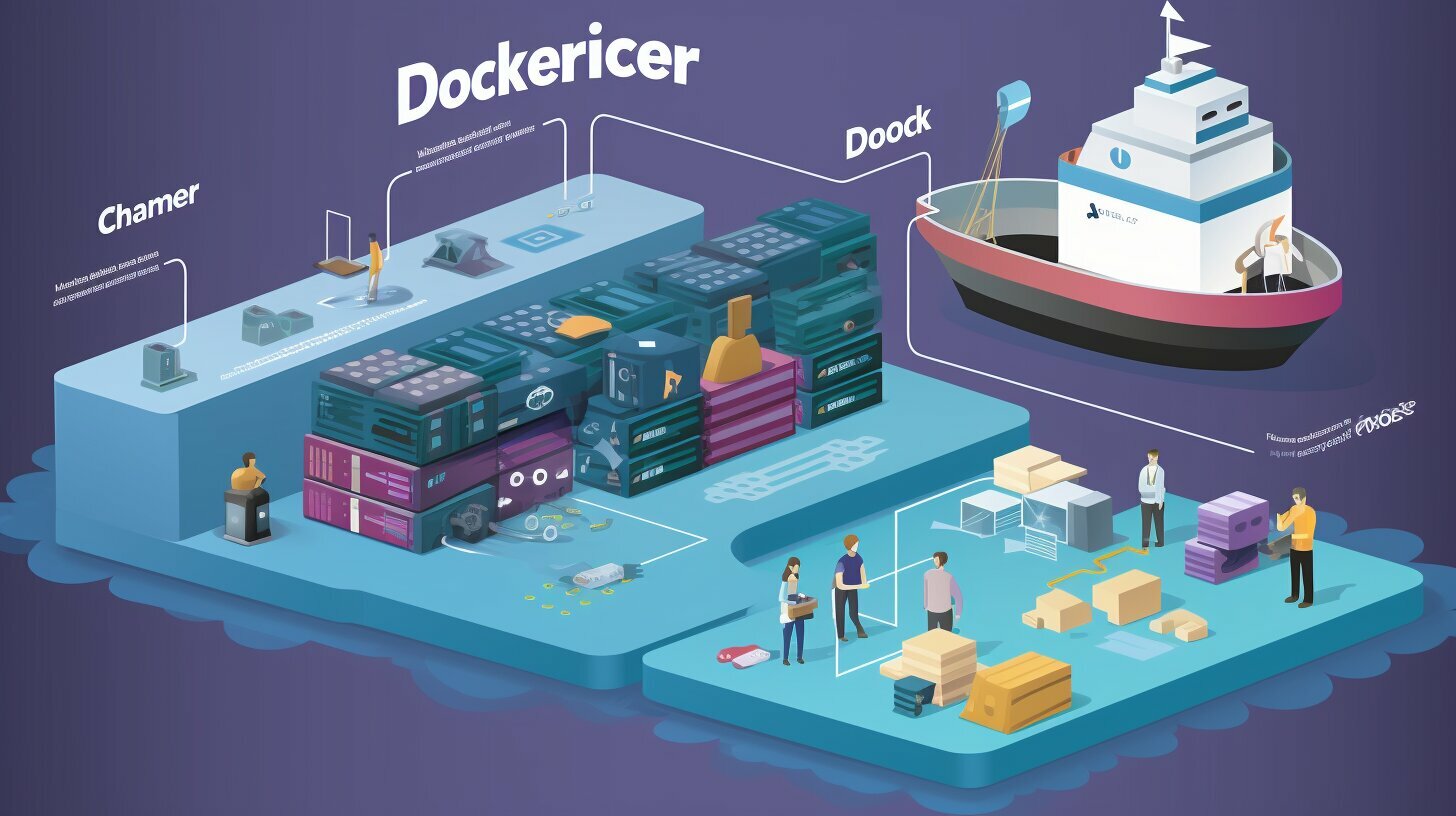Understanding the Basics: How Does Docker Work?
Docker is a container-based technology that revolutionizes container orchestration in DevOps environments. It is a popular open-source project that utilizes the Linux Kernel’s features, such as namespaces and control groups, to create lightweight and isolated environments called containers. Unlike traditional virtual machines, Docker containers do not require a separate operating system and instead leverage the host operating system. This makes them more efficient and portable.
The core components of Docker include Docker Engine (dockerd), docker-containerd (containerd), and docker-runc (runc). Docker Engine is responsible for building Docker images, which are templates containing all the specifications for running a container. Docker-containerd handles image downloading and container execution, while docker-runc creates the necessary namespaces and cgroups for a container to run securely.
Docker images can be easily created using a Dockerfile or pulled from a repository like Docker Hub. These images encapsulate the application and its dependencies, making it convenient to package and distribute software across different environments. The Docker Hub and Docker Registry serve as platforms for storing and sharing Docker images.
Docker’s efficient workflow simplifies the process of moving applications from development to production environments. With Docker, developers can build, test, and deploy applications consistently across various platforms, ensuring that the software functions as expected in each stage.
Key Takeaways:
- Docker is a container-based technology for container orchestration in DevOps environments.
- Containers are lightweight and isolated environments that contain all the resources needed to run a piece of software.
- Docker consists of Docker Engine, docker-containerd, and docker-runc as its main components.
- Docker images are templates that specify the configuration and dependencies required to run a container.
- Docker Hub and Docker Registry are platforms for storing and sharing Docker images.
What is Docker and How Does It Differ from Virtual Machines?
Docker is not a virtual machine solution, but rather a tool for managing containers efficiently. It is a container-based technology that is widely used in DevOps environments for container orchestration. While traditional virtual machines emulate an entire operating system and require a separate kernel for each instance, Docker containers leverage the Linux Kernel’s features like namespaces and control groups to create lightweight and isolated environments on top of an operating system.
Containers are highly portable, as they contain all the resources needed to run a piece of software, including the application, libraries, and dependencies. They do not require a separate guest operating system, making them more lightweight than virtual machines. Docker provides a platform-agnostic solution, enabling containers to run on any host with Docker installed, regardless of the underlying operating system.
Docker consists of three main components: Docker Engine, docker-containerd, and docker-runc. Docker Engine, also known as dockerd, is the foundation of Docker and is responsible for building Docker images, managing containers, and orchestrating their execution. Docker-containerd, or simply containerd, is a high-level container runtime that handles the downloading of images and running them as containers. Lastly, docker-runc, or runc, is the container runtime responsible for creating the namespaces and control groups required for a container.
One of the key advantages of Docker is its efficient workflow for moving applications from development to production environments. Docker containers provide a consistent environment across different stages of the software development lifecycle, allowing developers to package their applications and dependencies into portable containers. This eliminates the need for manual configurations and ensures that the application runs consistently regardless of the environment. With Docker, developers can focus on writing code while Docker takes care of the deployment and management of containers.
Table: Key Differences Between Docker and Virtual Machines
| Docker Containers | Virtual Machines |
|---|---|
| Lightweight and share the host operating system | Emulate an entire operating system |
| Use operating system-level virtualization | Use hardware-level virtualization |
| Start quickly and have faster boot times | Take longer to start and boot |
| Share the host’s kernel | Have a separate kernel for each instance |
| More efficient resource utilization | Provide hardware abstraction |
In summary, Docker is a container-based technology that efficiently manages containers for software deployment. It differs from traditional virtual machines by utilizing operating system-level virtualization, allowing for lightweight and portable containers that share the host operating system. Docker’s three main components, Docker Engine, docker-containerd, and docker-runc, work together to build, manage, and run containers. With its efficient workflow and ability to eliminate environment inconsistencies, Docker has become a popular choice for containerization in modern software development and DevOps practices.
Understanding Docker Components: Docker Engine, Containerd, and Runc
Docker consists of three main components: Docker Engine (dockerd), docker-containerd (containerd), and docker-runc (runc). Each component plays a crucial role in the containerization process, enabling the efficient deployment and execution of Docker containers.
Docker Engine: As the core component of Docker, Docker Engine is responsible for building Docker images and running containers. It provides a high-level API that allows users to interact with the Docker daemon, which manages the container lifecycle. Docker Engine utilizes containerd and runc to create and manage containers efficiently.
Containerd: Containerd is the container runtime used by Docker Engine. It handles the downloading and execution of container images, as well as managing the lifecycle of containers. Containerd ensures that containers are isolated, lightweight, and secure, using features provided by the Linux Kernel.
Runc: Runc is the low-level container runtime that Docker utilizes to create and run containers. It is responsible for setting up the necessary namespaces, control groups, and other isolation mechanisms required for a container to operate. Runc ensures that containers are isolated from each other and the host system, providing a secure and dependable runtime environment.
| Component | Role |
|---|---|
| Docker Engine | Builds Docker images and runs containers |
| Containerd | Handles downloading, execution, and lifecycle management of containers |
| Runc | Creates and runs containers, setting up necessary isolation mechanisms |
In summary, Docker’s three main components work together to enable efficient containerization. Docker Engine provides the high-level interface, while containerd and runc handle the runtime operations. This combination allows Docker to package and deploy applications into lightweight, isolated containers, making them portable and easy to manage across different environments.
Exploring Docker Images and Dockerfiles
Docker images serve as the blueprint for containers and can be easily created using a Dockerfile. A Docker image is a lightweight, standalone, and executable software package that includes everything needed to run a piece of software, including the code, runtime, libraries, and system tools. It encapsulates the application and its dependencies, making it portable and allowing it to run consistently across different environments.
A Dockerfile is a text file that contains a set of instructions for building a Docker image. It specifies the base image, the files and directories to be copied to the image, the commands to be run, and other configuration settings. By following the instructions in the Dockerfile, Docker can automatically build an image that exactly matches the desired specifications.
One of the key advantages of using Docker images and Dockerfiles is the ability to create reproducible and version-controlled containers. Dockerfiles can be stored in a code repository, enabling version control and collaboration among development teams. This ensures that containers are built consistently and can be easily reproduced, even across different environments or by different team members.
Additionally, Docker images can be shared and pulled from a repository, such as Docker Hub. Docker Hub is a cloud-based registry that hosts a wide range of pre-built Docker images, making it easy for developers to find and download images for their applications. This eliminates the need to manually build and configure images from scratch, saving time and effort in the development process.
| Advantages of Docker Images and Dockerfiles |
|---|
| Reproducibility: Dockerfiles enable the creation of consistent and reproducible containers. |
| Version Control: Dockerfiles can be stored in code repositories, allowing for version control and collaboration. |
| Portability: Docker images can be easily shared and run across different environments. |
| Time Savings: Docker Hub provides a repository of pre-built images, saving time in the development process. |
Utilizing Docker Hub and Docker Registry
Docker Hub and Docker Registry are essential tools for accessing and distributing Docker images. Docker Hub is a cloud-based registry where developers can store and share their Docker images. It serves as a central repository for the Docker community, offering a wide range of pre-built images that can be easily pulled and used for various applications. Docker Hub provides a convenient platform for collaboration and enables developers to share their images with others, making it easier to leverage existing solutions and accelerate the development process.
Docker Registry, on the other hand, is an open-source service that allows organizations to create their own private repositories for Docker images. This enables teams to securely store and manage their images internally, ensuring greater control and privacy over their software artifacts. Docker Registry can be deployed within your own infrastructure, giving you the flexibility to customize and tailor it to your specific needs. It provides a scalable and reliable solution for hosting Docker images, offering improved performance and reduced latency for internal image distribution.
Benefits of Docker Hub and Docker Registry
- Accessibility: Docker Hub provides a vast library of public images that can be easily accessed by developers worldwide, fostering collaboration and knowledge sharing. Docker Registry, on the other hand, allows organizations to securely store and distribute their private images, ensuring controlled access and tighter security.
- Reliability: Both Docker Hub and Docker Registry offer reliable and scalable solutions for hosting and distributing Docker images. They are designed to handle high loads and provide efficient image replication, ensuring fast and reliable access to the images.
- Community Support: Docker Hub has a strong and active community that contributes to the creation and maintenance of public images. This means that developers can benefit from the expertise and experience of others, reducing the time and effort required to build their own images.
- Version Control: Docker Hub and Docker Registry support versioning, allowing developers to manage different versions of their images. This makes it easy to roll back to previous versions if needed and ensures proper version control and management.
Both Docker Hub and Docker Registry play a crucial role in the Docker ecosystem, providing developers and organizations with the tools they need to access, distribute, and manage Docker images efficiently. Whether you need to leverage existing images from the Docker community or host your own private repository, these tools offer the convenience, scalability, and security required for effective containerized application development.
(table)
Docker HubDocker RegistryCloud-based repositorySelf-hosted solutionPre-built images availableCustomizable repositoryCollaborative platformEnhanced security and controlScalable and reliableEfficient internal image distribution
(tr)
The Role of Docker Daemon in Container Management
The Docker daemon plays a crucial role in managing and controlling Docker containers. It is responsible for overseeing the entire lifecycle of containers, from their creation to their termination. The daemon, also known as dockerd, is a background process that runs on the host machine and listens for Docker API requests. It communicates with other Docker components, such as docker-containerd and docker-runc, to ensure smooth and efficient container operations.
One of the primary functions of the Docker daemon is managing container images. It interacts with the Docker registry, which is a centralized repository for storing and distributing Docker images. The daemon pulls the necessary images from the registry and stores them locally on the host machine. It also handles image caching, optimizing the process of starting containers by reusing existing image layers whenever possible.
Container Management with Docker Daemon
Once the images are available, the Docker daemon oversees the creation and execution of containers. It uses the container runtime, docker-runc, to launch containers based on the specified image and configuration. The daemon creates the necessary namespaces and control groups (cgroups) for each container, ensuring isolation and resource allocation.
The Docker daemon continuously monitors running containers, tracking their resource utilization, network connectivity, and overall health. It provides essential functionalities like starting, stopping, pausing, and restarting containers as necessary. Additionally, the daemon facilitates container networking by managing the creation and configuration of network interfaces, routing, and port mapping.
A Powerful Tool for Container-Based Implementation
The Docker daemon’s role in container management makes it an indispensable tool for implementing containerization in versatile environments. With its efficient orchestration capabilities, Docker simplifies the development, testing, and deployment of applications across different systems and platforms. By leveraging Docker’s containerization features, organizations can achieve improved scalability, portability, and resource utilization, empowering them to meet the ever-evolving demands of modern microservice architecture effectively.
Overall, the Docker daemon plays a pivotal role in enabling the streamlined and efficient management of Docker containers. Its ability to handle image management, container execution, and monitoring makes it a vital component within the Docker ecosystem, facilitating the adoption and implementation of containerization in diverse software development and deployment scenarios.
| Docker Daemon | Function |
|---|---|
| Docker Engine (dockerd) | Oversees the entire lifecycle of containers and communicates with other Docker components. |
| Docker-Containerd | Manages container images, pulling them from the Docker registry and caching them locally. |
| Docker-Runc | Handles the creation and execution of containers, ensuring isolation and resource allocation. |
Understanding Containerization with Docker
Containerization with Docker offers a lightweight and isolated environment for running software applications. By leveraging the Linux Kernel’s features like namespaces and control groups, Docker creates containers on top of an operating system, making it an efficient solution for container orchestration, particularly in DevOps environments.
Docker is not a virtual machine solution but rather a tool for managing containers efficiently. Containers are lightweight and isolated environments that contain all the necessary resources to run a piece of software. Unlike traditional virtual machines, Docker containers utilize operating system-level virtualization, making them more lightweight and enabling faster startup times.
Docker consists of three main components: Docker Engine (dockerd), docker-containerd (containerd), and docker-runc (runc). Docker Engine is responsible for building Docker images, containerd manages the downloading of images and running them as containers, and runc creates the necessary namespaces and control groups for each container, allowing them to function independently and securely.
Key Components of Docker:
- Docker Engine: Builds Docker images and manages containers.
- Containerd: Downloads images and runs them as containers.
- Runc: Creates namespaces and control groups for containers.
Docker images serve as templates containing all the specifications for running a container. They can be easily created using a Dockerfile or pulled from a repository, such as Docker Hub. Docker Hub is a platform that provides a vast collection of pre-built Docker images, making it easy to share and distribute containerized applications.
The power of Docker lies in its ability to package applications and their dependencies into portable containers. This portability allows applications to run on any host with Docker installed, regardless of the underlying operating system or hardware. Docker’s efficient workflow simplifies the process of moving applications from development to production environments, streamlining the deployment and scaling of applications in a microservice architecture.
| Key Benefits of Docker |
|---|
| Improved resource utilization |
| Portability |
| Scalability |
| Ease of deployment |
Docker Workflow: From Development to Production Environments
Docker’s efficient workflow streamlines the deployment of applications across different environments. With Docker, developers can package applications and their dependencies into containers, ensuring consistency and eliminating the “it works on my machine” problem. Here’s a step-by-step guide to the Docker workflow:
- Develop: Developers start by writing code and creating a Dockerfile, which contains instructions for building the Docker image. The Dockerfile specifies the base image, dependencies, and any custom configurations needed.
- Build: Using the Dockerfile, developers run the Docker build command to build the Docker image. This process creates a reproducible and portable image that can be deployed to any Docker environment.
- Test: Once the image is built, developers can spin up containers from the image and run tests to ensure the application behaves as expected. Docker’s lightweight and isolated containers make testing easier and more reliable.
- Deploy: After successful testing, the Docker image can be deployed to the production environment. Docker simplifies the deployment process by providing a consistent and reliable runtime environment for the application.
Throughout the entire workflow, Docker offers a range of tools and services to enhance the development and deployment process. Docker Hub, a popular Docker registry, allows developers to store and share Docker images. It provides a central hub for discovering and collaborating on pre-built images. Additionally, Docker Compose enables the management of multi-container applications, making it easier to orchestrate complex deployments.
By leveraging Docker’s containerization technology, organizations can achieve faster and more efficient development cycles. Docker’s ability to package applications, along with their dependencies, into portable containers ensures consistent deployment across various environments, from development to production.
Docker Workflow in Action: An Example
To illustrate the Docker workflow, let’s consider a scenario where a development team is working on a web application. The team members have written code and created a Dockerfile for building the application’s Docker image. With the Dockerfile in place:
| Step | Command | Description | ||
|---|---|---|---|---|
| 1 |
|
Builds the Docker image using the Dockerfile in the current directory. | ||
| 2 |
|
Runs a container from the built image, mapping port 8080 on the host to port 80 on the container. | ||
| 3 |
|
Pushes the image to a Docker registry, making it available for deployment in other environments. |
In this example, the team builds the Docker image, runs it as a container, and then pushes it to a registry. The image can then be pulled from the registry and deployed to different environments, such as testing or production, all while maintaining consistency and reproducibility.
The Power of Docker in DevOps and Microservices
Docker’s container-based technology has revolutionized DevOps practices and enables efficient management of microservices. With its ability to encapsulate applications and their dependencies into lightweight and isolated containers, Docker has become a go-to tool for developers and operations teams alike.
One of the key advantages of Docker is its seamless integration with DevOps workflows. By using Docker, developers can package their applications and their dependencies into containers, ensuring consistent and reliable deployments across different environments. This eliminates the issue of “it works on my machine” and streamlines the development process.
Moreover, Docker facilitates the implementation and orchestration of microservices. Microservices architecture breaks down applications into smaller, independent services that can be developed, deployed, and scaled independently. Docker’s containerization allows each microservice to run in its own container, providing isolation and flexibility. It also simplifies the deployment of microservices across different environments, making it easier to scale and manage them efficiently.
By leveraging Docker in DevOps and microservices, organizations can achieve faster development cycles, improved scalability, and increased efficiency. Docker’s containerization technology provides a consistent and reliable environment for application deployment, ensuring that applications run smoothly in any environment. It also allows for easy scalability, as containers can be quickly spun up or down based on demand, enabling organizations to respond to changing needs effectively.
| Benefits of Docker in DevOps and Microservices: |
|---|
| – Improved development and deployment workflows |
| – Increased scalability and flexibility |
| – Simplified management and orchestration of microservices |
| – Consistent and reliable application deployments |
| – Enhanced resource utilization and efficiency |
In conclusion, Docker plays a crucial role in DevOps practices and the implementation of microservices. Its container-based technology brings numerous benefits, including streamlined development workflows, improved scalability, and simplified management of microservices. By adopting Docker, organizations can significantly enhance their software development and deployment processes in today’s fast-paced and dynamic environments.
Advantages and Benefits of Docker
Docker offers numerous advantages and benefits, making it a preferred choice for containerization. With its lightweight and isolated containers, Docker provides a more efficient alternative to traditional virtual machines. Here are some key advantages of using Docker:
- Improved Resource Utilization: Docker containers share the host system’s resources, allowing for better utilization of CPU, memory, and storage. This results in higher efficiency and cost savings.
- Portability: Docker enables easy portability of applications across different environments. Developers can package applications and their dependencies into Docker images, which can then be deployed on any host with Docker installed.
- Scalability: Docker simplifies the process of scaling applications. With Docker’s container orchestration capabilities, it becomes effortless to scale containers up or down based on demand, ensuring optimal resource allocation.
- Ease of Deployment: Docker provides a streamlined workflow for deploying applications. By encapsulating the application and its dependencies into a Docker image, the deployment process becomes consistent and reproducible across different environments.
“Docker containers offer improved resource utilization, portability, scalability, and ease of deployment, making it a preferred choice for containerization in modern software development.”
As Docker has gained popularity, it has become an essential tool for DevOps practices and microservices architecture. Docker simplifies the development and deployment process, allowing teams to focus on writing code rather than worrying about underlying infrastructure. By creating a standardized environment through Docker containers, teams can ensure consistent and efficient deployment across different stages of the software development lifecycle.
Hence, Docker’s advantages and benefits extend beyond its efficient resource utilization and portability. It empowers organizations to adopt a more agile and scalable approach to software deployment, driving innovation and accelerating time-to-market in today’s fast-paced technology landscape.
Summary:
Docker offers numerous advantages and benefits for containerization, including improved resource utilization, portability, scalability, and ease of deployment. Its lightweight and isolated containers provide an efficient alternative to traditional virtual machines. By encapsulating applications and their dependencies in Docker images, developers can easily deploy and scale applications across different environments. Docker simplifies the development and deployment process, making it an essential tool in DevOps practices and microservices architecture. Overall, Docker’s advantages make it a preferred choice for modern software development and deployment.
| Advantages | Benefits |
|---|---|
| Improved resource utilization | Efficient use of CPU, memory, and storage |
| Portability | Easy deployment on any host with Docker installed |
| Scalability | Effortless scaling of applications based on demand |
| Ease of deployment | Consistent and reproducible deployment process |
Conclusion
In conclusion, Docker provides an efficient and powerful solution for container-based implementation and orchestration in today’s microservice architecture. With its lightweight and isolated environments, Docker allows for the easy packaging of applications and their dependencies into containers, making them portable and enabling them to run on any host with Docker installed.
Docker’s three main components, Docker Engine (dockerd), docker-containerd (containerd), and docker-runc (runc), work together to create and manage containers. Docker Engine builds Docker images, while containerd downloads images and runs them as containers, and runc is responsible for creating the necessary namespaces and cgroups.
Docker images, which are templates containing all the specifications for running a container, can be easily created using a Dockerfile or pulled from a repository such as Docker Hub. This allows for easy sharing and distribution of applications. Docker’s efficient workflow simplifies the process of moving applications from development to production environments.
In the world of DevOps and microservices, Docker plays a pivotal role in improving resource utilization, portability, scalability, and ease of deployment. Its ability to create isolated containers enables faster development cycles and seamless integration of services, making it an invaluable tool for modern software development and deployment.
FAQ
How does Docker work?
Docker is a container-based technology that uses the Linux Kernel’s features like namespaces and control groups to create containers on top of an operating system. Containers are lightweight and isolated environments that contain all the resources needed to run a piece of software. Docker allows applications and their dependencies to be packaged into containers, making them portable and allowing them to run on any host with Docker installed.
How does Docker differ from virtual machines?
Docker containers are more lightweight than traditional virtual machines. While virtual machines require a separate operating system for each instance, Docker containers share the host operating system, making them faster and more resource-efficient.
What are the main components of Docker?
Docker consists of three main components: Docker Engine (dockerd), docker-containerd (containerd), and docker-runc (runc). Docker Engine is responsible for building Docker images, containerd is responsible for downloading images and running them as containers, and runc is the container runtime responsible for creating the namespaces and cgroups required for a container.
What are Docker images and Dockerfiles?
Docker images are templates that contain all the specifications for running a container. They can be easily created using a Dockerfile, which is a text file that contains instructions for building a Docker image. Dockerfiles provide a reproducible and automated way to create Docker images.
What is Docker Hub and Docker Registry?
Docker Hub and Docker Registry are platforms for storing and sharing Docker images. Docker Hub is a cloud-based repository where developers can publish and share their images, while Docker Registry is a private registry that allows organizations to securely manage and distribute Docker images within their network.
What is the role of the Docker daemon?
The Docker daemon, or dockerd, is responsible for managing Docker containers and orchestrating their execution. It listens for commands from the Docker client, pulls images from Docker Registry, and starts and stops containers based on the instructions it receives.
What are the advantages of using Docker?
Docker offers several advantages, including improved resource utilization, portability, scalability, and ease of deployment. It allows for easy application packaging and dependency management, simplifies the process of moving applications from development to production environments, and enables efficient containerization in microservice architectures.
What is the role of Docker in DevOps and microservices?
Docker plays a significant role in DevOps practices and the implementation and orchestration of microservices. It allows for efficient collaboration between development and operations teams by providing a consistent environment across the entire development lifecycle. Docker also enables the scalability and flexibility required for microservice architectures, facilitating the deployment and management of individual services.
- About the Author
- Latest Posts
Mark is a senior content editor at Text-Center.com and has more than 20 years of experience with linux and windows operating systems. He also writes for Biteno.com





